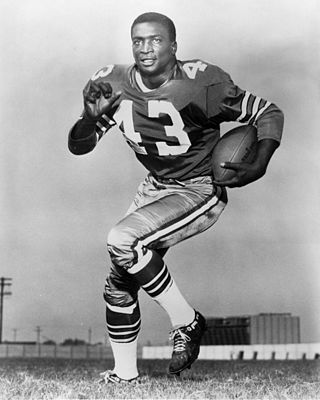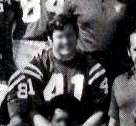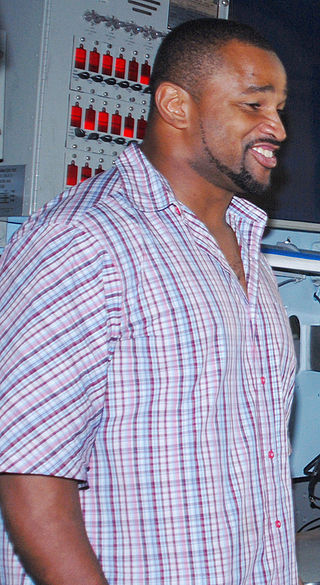
A running back (RB) is a member of the offensive backfield in gridiron football. The primary roles of a running back are to receive handoffs from the quarterback to rush the ball, to line up as a receiver to catch the ball, and block. There are usually one or two running backs on the field for a given play, depending on the offensive formation. A running back may be a halfback, a wingback, or a fullback. A running back will sometimes be called a "feature back" if he is the team's key player/more prominent running back.

Donald Anthony Perkins was an American professional football player who was a fullback in the National Football League (NFL) for the Dallas Cowboys. He played college football at the University of New Mexico.
Thomas Dean Rathman is an American former professional football player who was a fullback for the San Francisco 49ers and Los Angeles Raiders of the National Football League (NFL). He played college football for the Nebraska Cornhuskers.

Leonard Edward Moore is an American former football halfback and flanker who played in the National Football League (NFL) for the Baltimore Colts from 1956 to 1967. He played college football for the Penn State Nittany Lions. He was named the NFL Rookie of the Year in 1956 and was selected to the Pro Bowl seven times. Moore was inducted into the Pro Football Hall of Fame in 1975.

Fletcher Joseph Perry was an American football fullback who played in the All-America Football Conference (AAFC) and National Football League (NFL). He played for the San Francisco 49ers from 1948 to 1960, the Baltimore Colts from 1961 to 1962, and returned to the 49ers in 1963 for his final year in football. He was exceptionally fast, a trait uncommon for a fullback and one which earned him the nickname, "the Jet". The first African-American to be named the NFL Most Valuable Player (MVP), he became one of American football's first black stars.

Leroy Kelly is an American former professional football player who was a running back for the Cleveland Browns in the National Football League (NFL) from 1964 to 1973. He was inducted into the Pro Football Hall of Fame.

Billy Dale Vessels was an American professional football player at the halfback position. He played college football for the Oklahoma Sooners, winning a national championship in 1950 and being awarded the 1952 Heisman Trophy.

Thomas Roland Matte(Pronounced: MAT-tee) was an American professional football player who was a running back in the National Football League (NFL) in the 1960s and 1970s and earned a Super Bowl ring. He attended Shaw High School in East Cleveland and was an Eagle Scout. Matte was an All-American quarterback playing college football at Ohio State University.

John Henry Johnson was an American professional football player who was a running back. He was known for his excellence at the fullback position as both a runner and a blocker. His first professional stint was in Canada in the Western Interprovincial Football Union for one season with the Calgary Stampeders. He then played in the National Football League (NFL) for the San Francisco 49ers, Detroit Lions, and Pittsburgh Steelers before spending his final season in the American Football League (AFL) with the Houston Oilers. Commonly referred to as simply John Henry, an allusion to the folk hero of the same name, Johnson was a tough and tenacious player who performed at a high level well into the tail end of his career.

Lorenzo LaVonne Neal is an American former football fullback who played in the National Football League (NFL) for sixteen seasons. Neal played college football for the Fresno State Bulldogs and was selected by the New Orleans Saints in the fourth round of the 1993 NFL draft. A four-time Pro Bowl selection and three-time All-Pro, he was also a member of the New York Jets, the Tampa Bay Buccaneers, the Tennessee Titans, the Cincinnati Bengals, the San Diego Chargers, the Baltimore Ravens and the Oakland Raiders. Considered one of the best blocking fullbacks in NFL history, Neal blocked for a 1,000-plus-yard running back in eleven straight seasons from 1997 to 2007.

Preston James Pearson is an American former professional football player who was a running back in the National Football League (NFL) for the Baltimore Colts, Pittsburgh Steelers and Dallas Cowboys. He played college basketball for the Illinois Fighting Illini.

James Edward "Jimmy" Orr Jr. was an American professional football player who was a wide receiver in the National Football League (NFL) for 13 seasons, running from 1958 to 1970.

George Taliaferro was an American professional football player who was the first African American drafted by a National Football League (NFL) team. Beginning his football career at Indiana University for the Hoosiers team, he played in the NFL for the New York Yanks from 1950 to 1951, the Dallas Texans in 1952, the Baltimore Colts from 1953 to 1954, and Philadelphia Eagles in 1955.

Donald Frederick McCauley Jr. is an American former professional football player who was a running back for the Baltimore Colts of the National Football League (NFL). He played college football for the North Carolina Tarheels from 1968 to 1970, during which time he was twice recognized as the Atlantic Coast Conference (ACC) player of the year. He was also consensus All-American in 1970 and finished ninth in voting for the Heisman Trophy.
Detron Nigel Smith is an American former professional football player who was a fullback in the National Football League (NFL), primarily with the Denver Broncos. He played college football for the Texas A&M Aggies and was selected by the Broncos in the third round of the 1996 NFL draft. He was selected to the Pro Bowl in 1999.

Jacob Troy Hester is a former American football fullback who played professionally in the National Football League (NFL). He was selected by the San Diego Chargers in the third round of the 2008 NFL draft. He played college football at Louisiana State University.
Charles Edward "Chuck" Banks,Jr. is a former professional American football player who played Running back in the National Football League (NFL) for the Houston Oilers/Tennessee Titans and the Indianapolis Colts

The 1946 Michigan Wolverines football team represented the University of Michigan in the 1946 Big Nine Conference football season. In their ninth year under head coach was Fritz Crisler, the Wolverines compiled a 6–2–1 record, outscored opponents 233 to 73, and finished the season in second place in the Big Nine Conference and ranked No. 6 in the final 1946 AP poll. The team's two losses came against an undefeated Army team that was ranked No. 2 in the final AP poll and against an Illinois team that won the Big Nine championship and was ranked No. 5 in the final AP poll. Michigan won its last four games by a combined score of 162 to 19, starting a 25-game winning streak that continued for nearly three years until October 8, 1949. In the final game of the 1946 season, Michigan defeated Ohio State, 58–6, the Buckeyes' worst defeat since joining the conference in 1913.
Perry Lee Dunn, was a professional American football running back in the National Football League, for the Dallas Cowboys, Atlanta Falcons and Baltimore Colts. He played college football at the University of Mississippi.
The 1963 Arizona State Sun Devils football team was an American football team that represented Arizona State University in the Western Athletic Conference (WAC) during the 1963 NCAA University Division football season. In their sixth season under head coach Frank Kush, the Sun Devils compiled an 8–1 record, won the WAC championship, and outscored their opponents by a combined total of 249 to 122.
















